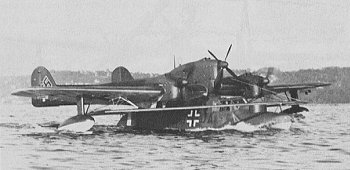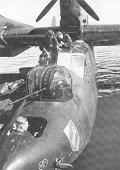
BV 138
The BV 138 was handicapped by not being strong enough to withstand the battering of prolonged operation on the open seas, and the prototype had to be extensively redesigned after showing severe instability on the water. After major modifications, the aircraft entered squadron service in 1940, initially proving unreliable. However, the aircraft's problems were later solved and it went on to provide good service, flying important naval reconnaissance missions against Allied convoys, especially in the Atlantic and Barents Sea. Two BV 138s even operated from the frozen wastes of Novaya Zemlya with the support of U-boats.
In addition to shore bases, BV 138s flew from seaplane tenders, some modified with catapults for launch. All BV 138s were able to use assisted take-off rockets and some carried FuG 200 Hohentwiel radar for shadowing convoys. The BV 138 could even fight off Allied fighters, as one crew showed by downing a Blenheim over Norway. The final version was fitted with a giant electromagnetic ring for triggering magnetic mines.
The Blohm und Voss BV 138 was crucial to Germany's naval war effort. It was the brainchild of Dr Ing Richard Vogt, and although it suffered from initial structural weaknesses the BV 138 had a successful career as a maritime patrol aircraft and anti-ship bomber. Despite extensive problems with the initial design, the BV 138 eventually proved to be a capable machine and was later adapted for minesweeping.
A BV 138 was one of the last planes to leave Berlin on 1 May 1945, taking off from a lake with wounded troops. In 1941 a BV 138 shot down an RAF Catalina over the North Sea.
 |
 |
 |
| Takeoff was a prolonged business due to its excessive hull drag. After a major redesign, many initial problems were solved and the aircraft went on to provide invaluable service. Many BV 138s served alongside German U-boats in the Battle of the Atlantic, providing vital reconnaissance against Allied convoys |
The BV 138 was used mostly for air sea rescue and maritime patrol. In 1941, it had shot down a RAF Catalina and could even fight off Allied fighters, as one crew shot down a Blenheim over Norway. In its final configuration, the BV 138 was fitted with a large electromagnetic ring for minesweeping operations. |
The nose armament on the BV-138 was especially effective. It was power operated with a 20mm MG FF cannon. The BV 138B-1 used the faster firing MG151 cannon. |
|
BV 138 (Technical Specification) |
| Role |
Reconnaissance flying boat |
| Manufacturer |
Blohm Und Voss |
| Maximum Speed |
285 kmh (177 mph) |
| Maximum Range |
5,000 km (3,107 miles) |
| Ceiling |
5,000 meters (16,400 feet) |
Weight
Empty
Maximum Takeoff |
11,770 kg (25,948 lbs)
17,650 kg (38,912 lbs) |
Dimensions
Wingspan
Length
Height
Wing Area |
27.00 meters (88 ft, 7 in)
19.90 meters (65 ft, 3 in)
5.90 meters (19 ft, 4 in)
112 square meters (1,206 sq ft) |
| Engines |
Three Junkers Jumo 205D inline piston engine each providing 656-kW (880-hp) |
| Armament |
One 20mm (0.79 in) MG 151 cannon in the bow turret
One 13mm (0.51 in) MG 131 machine-gun at the rear centre engine nacelle
One 7.92mm (0.31 in) MG 15 firing through starboard hatch
Three 50 kg (110 lb) bombs under starboard wingroot or six 50 kg (110 lb) bombs or four 150 kg (330 lb) depth charges (BV 138C-1/U1) |
Photo Gallery
Click here to submit your photo
| Have A Passion For Aircraft? |
Subscribe to our 14 series FREE newsletter
delivered weekly on World War 2 Aircraft factfile... |
| NB:- We hate spam as much as you do, so your email address will NEVER be shared with or sold to anyone else. That's a Guarantee. |
|
|






